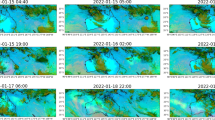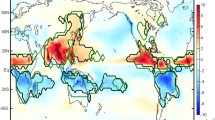Abstract
We examine the meteorological responses due to the probable eruption of Mt. Baekdu using an off-line Climate-Chemistry model that is composed of the National Center for Atmospheric Research (NCAR) Climate Atmosphere Model version 3 (CAM3) and a global chemistry transport model (GEOS-Chem). Using the aerosol dataset from the GEOS-Chem driven by GEOS-5 meteorology, experiment and control simulations of the climate model are performed and their meteorological differences between the two simulations are analyzed. The magnitudes of volcanic eruption and column injection height were presumably set to 1/200 of the Mt. Pinatubo eruption and 9 km, respectively. Significant temperature drop in the lower troposphere (850 hPa), which is mainly due to a direct effect of prescribed volcanic aerosols from Mt. Baekdu, has been simulated up to about −4 K. The upper atmosphere (150 hPa) right above the volcano, however, shows significant warming due to the absorption of the infrared radiation by volcanic aerosols. As a result of the volcanic eruption in the climate model, wave-like patterns are shown in both the geopotential height and horizontal wind. The changes in the lower atmospheric temperature are well associated with the modification of the atmospheric circulation through the hydrostatic balance. In spite of limitations in our current simulations due to several underlying assumptions, our results could give a clue to understanding the meteorological impacts from Mt. Baekdu eruptions that are currently attracting considerable public attention.
Similar content being viewed by others
References
Andronova, N. G., E. V. Rozanov, F. Yang, M. E. Schlesinger, and G. L. Stenchikov, 1999: Radiative forcing by volcanic aerosols from 1850 through 1994. J. Geophys. Res., 104, 16807–16826.
Bluth, G. J. S., S. D. Doiron, A. J. Krueger, L. S. Walter, and C. C. Schnetzler, 1992: Global tracking of the SO2 clouds from the June 1991 Mount Pinatubo eruptions. Geophys. Res. Lett., 19, 151–154.
Collins, W. D., and Coauthors, 2006: The community climate system model version 3 (CCSM3). J. Climate, 19, 2122–2143.
Dickinson, R. E., and Coauthors, 2006: The Community Land Model and its climate statistics as a component of the Community Climate System Model. J. Climate., 19, 2302–2324.
Graf, H. F., I. Kirchner, A. Robock, and I. Schult, 1993: Pinatubo eruption winter climate effects: Model versus observations. Climate Dyn., 9, 81–93.
____, and C. Timmreck, 2001: A general climate model simulation of the aerosol radiative effects of the Laacher See eruption (10,900 B.C.). J. Geophys. Res., 106, 14747–14756.
Groisman, P. Y., 1992: Possible regional climate consequences of the Pinatubo eruption: An empirical approach. Geophys. Res. Lett., 19, 1603–1606.
Guo, Z., J. Liu, J. Han, H. He, G. Dai, and H. You, 2006: Effect of gas emissions from Tianchi volcano (NE China) on environment and its potential volcanic hazards. Sci. China Ser. D., 49, 304–310.
Free, Melissa, and L. John, 2009: Effect of volcanic eruptions on the vertical temperature profile in radiosonde data and climate models. J. Climate, 22, 2925–2939.
Hansen, J., A. Lacis, R. Ruedy, and M. Sato, 1992: Potential climate impact of Mount Pinatubo eruption. Geophys. Res. Lett., 19, 215–218.
Horn, S., and H.-U. Schmincke, 2000: Volatile emission during the eruption of Baitoushan volcano (China/North Korea ca. 969 AD). B. Volcanol., 61, 537–555.
Ji, L., J. Xu, X. Lin, and P. Luan, 2010: Application of satellite thermal remote sensing in monitoring magmatic activity of Changbaishan Tianchi volcano. Chinese Sci. Bull., 55, 2731–2737.
Li, X., M. Li, and R. Liu, 1996: The climate effects of the Changbaishan-Tianchi Volcano eruption. Seismological and Geomagnetic Observation and Res., 17, 12–18. (in Chinese with English abstract)
Park, R. J., D. J. Jacob, B. D. Field, R. M. Yantosca, and M. Chin, 2004: Natural and trans-boundary pollution influences on sulfate-nitrate-ammonium aerosols in the United States: implications for policy. J. Geophys. Res., 109, D15204.
Ramachandran, S., V. Ramaswamy, G. L. Stenchikov, and A. Robock, 2000: Radiative impact of the Mount Pinatubo volcanic eruption: Lower stratospheric response. J. Geophys. Res., 105, 24409–24429.
Rayner, N. A., and Coauthors, 2003: Global analyses of sea surface temperature, sea ice, and night marine air temperature since the late nineteenth century, J. Geophys. Res., 108, 4407, doi:10.1029/2002JD002670.
Robock, A., 2000: Volcanic eruptions and climate. Rev. Geophys., 38, 191–219.
____, and J. Mao, 1995: The volcanic signal in surface temperature observations. J. Climate, 8, 1086–1103.
Sigurdsson, H., and S. Carey, 1989: Plinian and co-ignimbrite tephra fall from the 1815 eruption of Tambora Volcano. B. Volcanol., 51, 243–270.
Stenchikov, G., I. Kirchner, A. Robock, H.-G. Graf, J. C. Antuna, R. G. Grainger, A. Lambert, and L. Thomson, 1998: Radiative forcing from the 1991 Mount Pinatubo volcanic eruption. J. Geophys. Res., 103, 13837–13857.
____, A. Robock, V. Ramaswamy, M. D. Schwarzkopf, K. Hamilton, and S. Ramachandran, 2002: Arctic Oscillation response to the 1991 Mount Pinatubo eruption: Effects of volcanic aerosols and ozone depletion. J. Geophys. Res., 107, 4803.
Stothers, R. B, 1984: The great Tambora eruption in 1815 and its aftermath. Science, 224, 1191–1198.
Timmreck, C., H.-F. Graf, and I. Kirchner, 1999: A one and half year interactive MA/ECHAM4 simulation of Mount Pinatubo Aerosol. J. Geophys. Res., 104, 9337–9359.
____, and _____, 2006: The initial dispersal and radiative forcing of a Northern Hemisphere mid-latitude super volcano: a model study. Atmos. Chem. Phys., 6, 35–49.
Wallace, P. J., 2001: Volcanic SO2 emissions and the abundance and distribution of exsolved gas in magma bodies. J. Volcanol. Geoth. Res., 108, 85–106.
Wei, H., R. Liu, and X. Li, 1997: Ignimbrite-forming eruptions from Tianchi Volcano and their climate effect. Earth Science Frontiers (China University of Geosciences, Beijing), 4, 263–266 (in Chinese with English abstract).
____, S. J. Sparks, R. Liu, Q. Fan, Y. Wang, H. Hong, H. Zhang, H. Chen, C. Jiang, J. Dong, Y. Zheng, and Y. Pan, 2003: Three active volcanoes in China and their hazards. J. Asian Earth Sci., 21, 525–526.
Wu, J.-P., Y.-H. Ming, H.-R. Zhang, W. Su, and Y.-M. Liu, 2005: Seismic activity at the Changbaishan Tianchi volcano in the summer of 2002. Chinese J. Geophys-CH., 48, 621–628 (in Chinese with English abstract).
____, _____, _____, G.-M. Liu, L.-H. Fang, W. Su, and W.-L. Wang, 2007: Earthquakes swarm activity in Changbaishan Tianchi volcano. Chinese J. Geophys., 50, 938–946.
____, _____, L. Fang, and W. Wang, 2009: S-wave velocity structure beneath Changbaishan volcano inferred from receiver function. Earthq. Sci., 22, 409–416.
Yang, F., and M. E. Schlesinger, 1999: On the surface and atmospheric temperature changes following the 1991 Pinatubo volcanic eruption: A GCM study. J. Geophys. Res., 104, 9337–9360.
Youn, D., and Coauthors, 2011: Impacts of aerosols on regional meteorology due to Siberian forest fires in May 2003. Atmos. Environ. 45, 1407–1412.
Zou, H., Fan Q., and Zhang H., 2010: Rapid development of the great Millennium eruption of Changbaishan (Tianchi) Volcano, China/North Korea: Evidence from U-Th zircon dating. Lithos, 119, 289–296.
Author information
Authors and Affiliations
Corresponding author
Rights and permissions
About this article
Cite this article
Moon, BK., Youn, D., Park, R.J. et al. Meteorological responses to Mt. Baekdu volcanic eruption over east asia in an offline global climate-chemistry model: A pilot study. Asia-Pacific J Atmos Sci 47, 345–351 (2011). https://doi.org/10.1007/s13143-011-0021-z
Received:
Revised:
Accepted:
Published:
Issue Date:
DOI: https://doi.org/10.1007/s13143-011-0021-z




